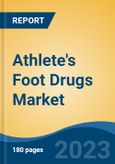Speak directly to the analyst to clarify any post sales queries you may have.
10% Free customizationThis report comes with 10% free customization, enabling you to add data that meets your specific business needs.
With approximately 15% of the global population experiencing fungal infections, the need for accessible and efficacious therapies is apparent. The market includes a variety of treatment options, ranging from over-the-counter topical formulations to prescription-strength medications. Pharmaceutical companies continue to invest in research and development to introduce novel therapies and improve drug delivery mechanisms. While North America and Europe currently lead due to better healthcare infrastructure and awareness, the Asia-Pacific and Latin American regions are experiencing accelerated growth driven by improving healthcare access and rising personal hygiene consciousness.
Key Market Drivers
Prevalence of Athlete's Foot
The widespread occurrence of athlete’s foot continues to be a primary factor fueling market expansion. This contagious fungal condition is frequently encountered in shared public environments, such as locker rooms and pools, and is especially prevalent among athletes and workers exposed to persistent moisture. The high transmission rate and discomfort associated with the condition compel affected individuals to seek pharmaceutical interventions. As the global incidence of tinea pedis remains elevated, the demand for antifungal treatments sustains the growth momentum of the athlete’s foot drug market.Key Market Challenges
Resistance to Antifungal Medications
A significant challenge facing the Global Athlete’s Foot Drugs Market is the increasing resistance to antifungal medications. Repeated and sometimes inappropriate use of antifungal agents can result in reduced drug efficacy as fungal strains adapt and become more resilient. This not only compromises treatment outcomes but also increases the risk of prolonged infections and patient dissatisfaction. Continued use of ineffective treatments due to resistance can diminish consumer confidence in available products and hinder market progress. Addressing this challenge requires the development of innovative therapies with broader and more durable efficacy profiles.Key Market Trends
Combination Therapies
Combination therapies have gained traction as a promising approach to managing athlete’s foot. These treatments utilize multiple antifungal agents with distinct mechanisms of action to enhance therapeutic outcomes and reduce the risk of resistance. Particularly effective in persistent or recurring cases, combination therapies have shown faster symptom relief and higher eradication rates. Their adaptability allows for personalized treatment strategies tailored to the severity of individual cases. Pharmaceutical companies have responded by developing diverse combination formulations, expanding therapeutic options and reinforcing market growth through innovation and improved patient satisfaction.Key Players Profiled in this Athlete’s Foot Drugs Market Report
- Novartis AG
- Vibcare Pharma Pvt. Ltd.
- Bayer AG
- Taro Pharmaceutical Industries Ltd
- Glenmark Pharmaceuticals Ltd.
- Abigail Healthcare Pharmaceutical
- ANI Pharmaceuticals, Inc.
- Perrigo Company plc
- Xiromed
- Sebela Pharmaceuticals
Report Scope:
In this report, the Global Athlete’s Foot Drugs Market has been segmented into the following categories, in addition to the industry trends which have also been detailed below:Athlete’s Foot Drugs Market, by Type:
- Toe Web Infection
- Moccasin-type Infection
- Ulcerative Infection
Athlete’s Foot Drugs Market, by Product Type:
- Topical Creams and Ointments
- Sprays
- Lotions
- Oral Medications
- Others
Athlete’s Foot Drugs Market, by Drug Class:
- Antifungal Agents
- Corticosteroid
- Antibiotics
- Others
Athlete’s Foot Drugs Market, by Distribution Channel:
- Hospital Pharmacies
- Retail Pharmacies
- Online Pharmacies
Athlete’s Foot Drugs Market, by Region:
- North America
- United States
- Canada
- Mexico
- Europe
- France
- United Kingdom
- Italy
- Germany
- Spain
- Asia-Pacific
- China
- India
- Japan
- Australia
- South Korea
- South America
- Brazil
- Argentina
- Colombia
- Middle East & Africa
- South Africa
- Saudi Arabia
- UAE
- Kuwait
- Turkey
- Egypt
Competitive Landscape
Company Profiles: Detailed analysis of the major companies present in the Global Athlete’s Foot Drugs Market.Available Customizations:
With the given market data, the publisher offers customizations according to a company's specific needs. The following customization options are available for the report.Company Information
- Detailed analysis and profiling of additional market players (up to five).
This product will be delivered within 1-3 business days.
Table of Contents
Companies Mentioned
The leading companies profiled in this Athlete’s Foot Drugs market report include:- Novartis AG
- Vibcare Pharma Pvt. Ltd.
- Bayer AG
- Taro Pharmaceutical Industries Ltd
- Glenmark Pharmaceuticals Ltd.
- Abigail Healthcare Pharmaceutical
- ANI Pharmaceuticals, Inc.
- Perrigo Company plc
- Xiromed
- Sebela Pharmaceuticals
Table Information
| Report Attribute | Details |
|---|---|
| No. of Pages | 185 |
| Published | May 2025 |
| Forecast Period | 2024 - 2030 |
| Estimated Market Value ( USD | $ 965.34 Million |
| Forecasted Market Value ( USD | $ 1310 Million |
| Compound Annual Growth Rate | 5.2% |
| Regions Covered | Global |
| No. of Companies Mentioned | 11 |









